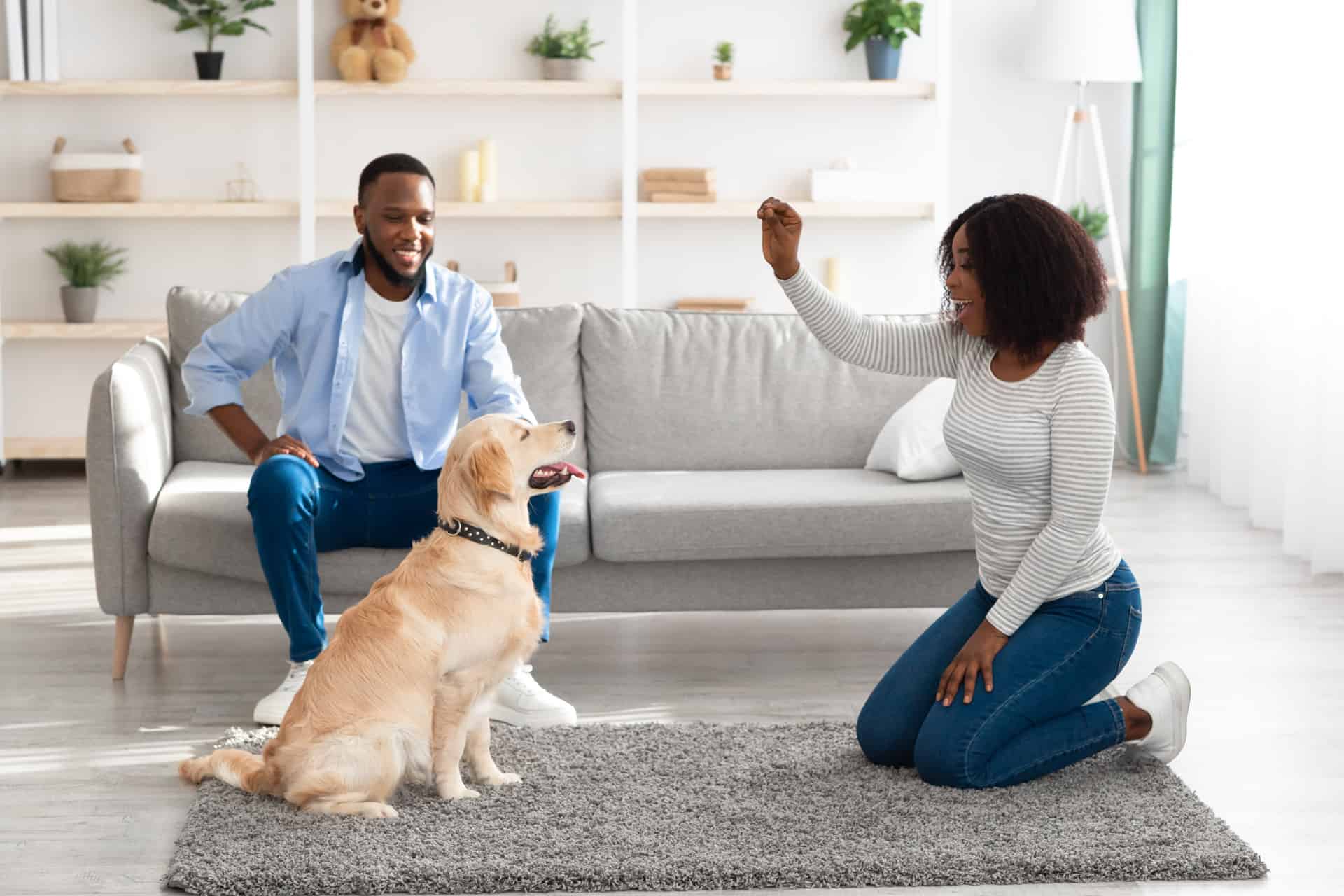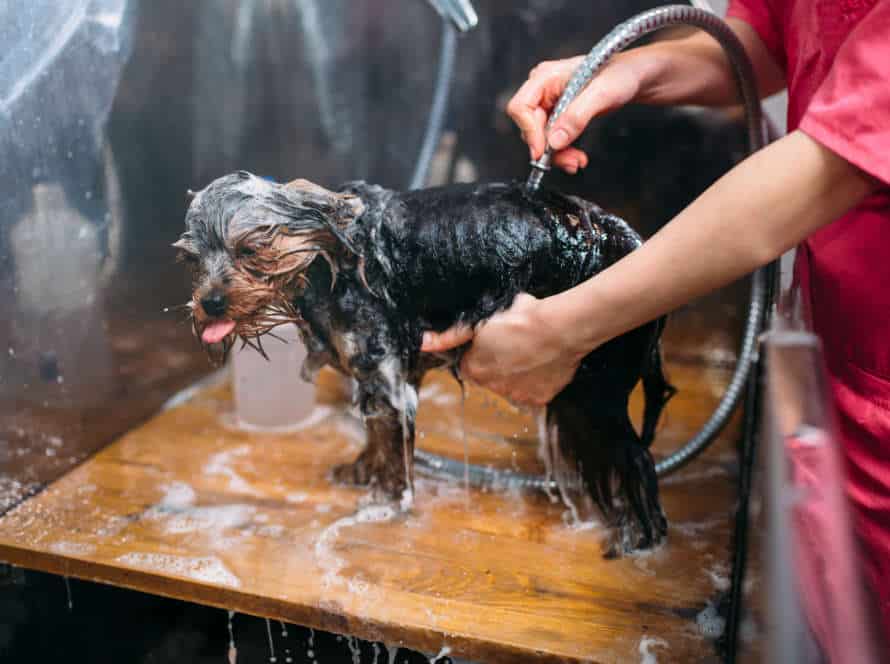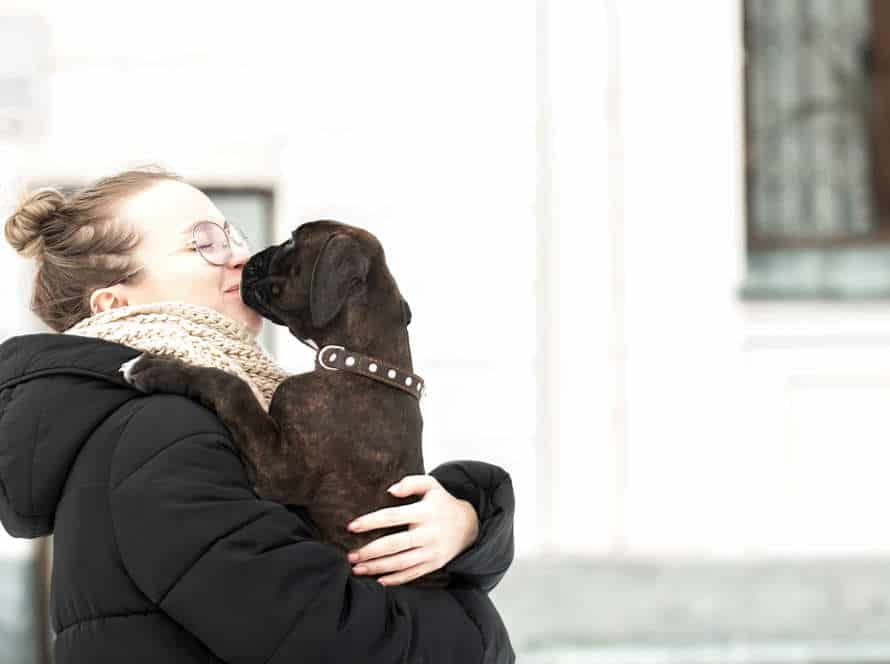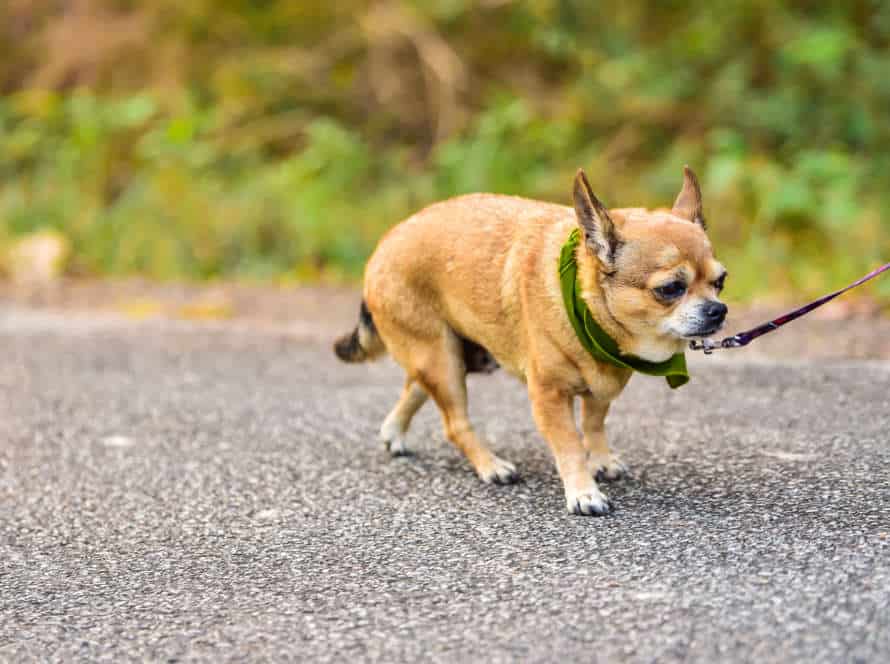Positive Reinforcement Techniques: Strategies for Success in Dog Training
Positive reinforcement is a humane, great way to train your pup! Here are four strategies to help you out:
- Treats! Use small, high-value treats that your dog will love and gobble up quickly.
- Be consistent. Everyone in the house should use the same techniques for training.
- Use a clicker. It makes a clicking sound when pressed. This signals to your dog that they did something right and a treat is coming.
- Keep it short. Training sessions should be no longer than 5 to 10 minutes. Do them throughout the day without overdoing it.
Remember: positive reinforcement is about trust and respect. It takes time and patience. Pro tip: end each session on a positive note to keep your pup motivated and excited for the next one.
Understanding Positive Reinforcement
Positive reinforcement is a must for dog training. It’s a way to shape behavior with rewards and encouragement. To use it effectively, one must understand it. This article will give an overview of positive reinforcement and the strategies for it. Get ready to train that pup!
Definition of Positive Reinforcement
Positive reinforcement is a behavior modification strategy used in dog training. You reward doggos with treats or praise when they show desirable behaviors.
Here are some common positive reinforcement techniques:
- Clicker Training: Use a clicker to reinforce good behavior. As soon as they do the desired behavior, click the clicker then give a treat or praise.
- Treat-Based Training: Give a treat when they act correctly. The treat should come right away to encourage the behavior.
- Praise: Verbally praise the pup when they do the desired behavior. Use a cheerful, upbeat tone for best results.
For positive reinforcement to work, the doggo should be motivated and attentive. Keep the training sessions short so they don’t get bored or lose interest. Pro tip: Always reward desirable behavior. Be consistent!
Benefits of Positive Reinforcement in Dog Training
Positive reinforcement is a great way to train your pup! No punishment, just rewards for good behavior – and the benefits are endless!
- Trust and a stronger bond with your dog.
- Encouraging the behaviors you want.
- Boosting their self-confidence.
- Making training a positive, fun experience.
- Reducing aggressive or fearful reactions.
Treats, verbal praise, toys, and affection – that’s what you need to reinforce and reward your pet’s good behavior. By staying consistent with these strategies, your pup will learn commands and behaviors, and live a happy life with you as a well-behaved companion.
How Positive Reinforcement Differs from Punishment-Based Methods
Positive reinforcement and punishment-based methods are two different approaches to dog training. They create different outcomes and affect the pup’s behaviour in opposite ways.
Positive reinforcement involves rewarding your dog when it does the right thing. This could be with treats, toys, kind words or cuddles.
This way builds trust and strengthens the bond between you and your pup, and can lead to a lasting, positive change in their behaviour.
On the other hand, punishment-based methods involve scolding, shouting, hitting or using shock collars to correct the dog’s behaviour.
Whilst this method may work in the short-term, it can cause fear, anxiety, and aggression in the pup. It can also damage the relationship with your furry friend.
To have success in dog training, positive reinforcement is the most effective and humane way to encourage good behaviour and create a loving, lasting bond between you and your pooch.
Applying Positive Reinforcement Techniques
Positive reinforcement techniques are popular for dog training. They help dogs learn quickly and calmly, without fear or aggression. A main way to use positive reinforcement is to give rewards like treats, toys, or other incentives for the wanted behavior. Let’s explore how positive reinforcement techniques can help train your dog successfully.
Identify Your Dog’s Motivators
Before starting positive reinforcement training, it is key to work out what motivates your dog.
Food, playtime, attention, toys and outdoor activities are often motivators.
See what works by offering different rewards, and watch their response.
Your dog’s motivators may vary, so it is a smart idea to keep an eye on their reaction to rewards and alter your training plan accordingly.
By understanding their motivators, you can build a positive reinforcement training plan which boosts their skills and strengthens the bond with you.
Timing and Consistency in Reward-Based Training
Timing and consistency are vital when using reward-based training in dog training. Positive reinforcement has been shown to work, yet timing and consistency are necessary for success.
Timing is important because dogs need an immediate, clear cause and effect relationship to understand their behavior is being reinforced. For example, to get a dog to sit or stay, the treat or praise must be given straight after the behavior.
Consistency is equally crucial. Dogs understand the rules and expectations through repetition. If you want your dog to sit before going outside, you must reinforce it consistently. Failing to do this can hinder progress.
In short, positive reinforcement techniques for dog training require clear communication between you and your dog, with emphasis on timing and consistency.
Using Clicker Training for Positive Reinforcement
Clicker training is a positive reinforcement technique that rewards and works well with dogs. It uses a device which emits a distinct sound when the desired action is done. After that, a reward is given, like treats or affection.
This is how to use clicker training for positive reinforcement:
- Pick an action you want your pup to do.
- Show the clicker to them and click it right away. Give them a treat afterwards.
- Wait for the desired action, then click and give a treat.
- Do this repeatedly, gradually reducing the treats and relying on the clicker’s sound as a reward.
Keep the sessions short and positive. Reward nice behavior instead of punishing bad behavior. With patience and persistence, clicker training can be a useful tool for successful dog training.
Positive Reinforcement Training Tips
Positive reinforcement is an awesome way to teach new behaviors to pups. Praise, treats and rewards are given to encourage good doggy behavior. What’s more, positive reinforcement training strengthens the connection between pooch and owner. Let’s look at tips and strategies for successful positive reinforcement dog training!
Reward Your Dog Frequently for Good Behavior
To successfully train your dog, use positive reinforcement.
This means rewarding your pup frequently for good behavior. Opt for small, bite-sized treats as rewards. Be consistent to ensure your pup knows what to expect.
Verbal praise can also be used in place of treats. For example, say “good boy” or “good girl” when your pup listens.
Avoid punishing bad behavior; redirect their attention & reward them for good behavior.
Pro tip: Always have treats ready & use a happy tone when giving verbal praise to make your pup feel even more loved!
Gradual Progression & Breaking Down Tasks into Smaller Steps
Positive reinforcement training is useful for teaching dogs new behaviors or commands. To make it successful, break tasks into smaller steps and use gradual progression.
Here’s how:
- Identify the behavior or command you want to teach your pup.
- Divide it into smaller steps.
- Start with the first step. When they get it right, praise and reward them.
- Only move on to the next step after your dog has mastered the first.
- As they progress, make the steps harder until they can do the desired behavior or command.
- Always use positive reinforcement like treats, toys, or verbal praise to encourage them during the session.
Incorporating Distraction Training to Build Focus
Distraction training is effective for focus and obedience. Here are tips for using positive reinforcement:
- Start with basic commands like ‘sit’, ‘stay’, ‘come’ and ‘down’.
- Gradually increase the level of distraction around your pup. Try commands with toys, food and other dogs/people.
- Use treats, praise and play as rewards for following commands despite distractions.
- Be patient and consistent. Repeat the process regularly, increasing the level of distraction gradually.
Focus takes time and effort. With positive reinforcement and patience, you can help your dog become well-behaved.
Key Mistakes to Avoid in Positive Reinforcement Training
Positive reinforcement training can be amazing for teaching your pup. But, certain mistakes can ruin the success. When done right, this type of training builds a good relationship and helps with obedience. To get the best results, it is important to avoid these key errors. Let’s take a look!
Inconsistency with Rewarding Good Behavior
Avoid the key mistake of inconsistency when rewarding good behaviour with positive reinforcement training.
Dogs learn through repetition and consistency, so always reward them when they do something good.
These common mistakes should be avoided for successful positive reinforcement techniques:
- Timing inconsistency: Reward the dog straight away when they do something good for reinforcing the same.
- Inadequate rewards: Choose meaningful rewards, like their favourite treat or toy.
- Overusing treats: Don’t rely too much on treats to avoid dependence or obesity. Remember, treats are not the only source of positive reinforcement- praise, physical touch and verbal recognition are important too.
- Using punishment: Positive reinforcement is about rewarding good behaviour and avoiding punishment, as it reinforces negativity amongst dogs. Don’t threaten with physical punishment or scolding when they don’t understand- shift focus and try again!
Consistency, clarity and patience are key for effective dog training with positive reinforcement.
Using Reward-Based Training for Behavioral Correction Instead of Preventatively
Reward-based training is a better, kinder way to teach your pup good behavior. It’s about rewarding them for what they do right, not punishing them for what they do wrong. Here’s how to get the most from reward-based training:
- Don’t give treats at random. Give them right after the desired behavior.
- Verbal and physical praise are just as important as treats.
- Don’t overdo it with the treats – otherwise they’ll lose their effectiveness.
- No punishment or negative reinforcement – just rewards.
- Be consistent & patient – that’s the key!
Expecting Too Much Progress Too Soon
Setting unrealistic expectations can be a major obstacle to successful positive reinforcement training for dogs. It’s important to remember that training a pup takes patience and time.
To prevent this mistake, it’s best to establish reasonable targets. Dogs must be given time to learn and grow. Unreasonable goals can lead to frustration for both the pup and the trainer. This can disrupt the bond of trust and make training more difficult.
Rather than expecting rapid progress, break down tasks into smaller, achievable goals. That way, the pup can satisfy their progress needs and stay motivated. Positive reinforcement training is a powerful tool, but it requires commitment and dedication to get results.
Conclusion and Final Thoughts
Conclusively, positive reinforcement techniques are a sure-fire way to successfully train a dog. By rewarding good behavior and ignoring bad behavior, dogs can be taught swiftly and effectively. Such techniques can be used for multiple training goals, from obedience and commands to behavior modification.
Patience, consistency, and timing are of utmost importance when using positive reinforcement techniques with your pup. Rewards that your dog finds valuable, given at the right moments, will aid your pet in learning.
To sum up, positive reinforcement techniques are humane, efficient, and enjoyable for both you and your four-legged pal. With practice and commitment, you’ll attain great success in training your pup using these techniques.
Pro Tip: Always use positive reinforcement with your dog; punishment or negative reinforcement can be damaging and counterproductive.
Frequently Asked Questions
Q: What is positive reinforcement in dog training?
A: Positive reinforcement is a training technique that rewards the desired behavior with something positive, such as a treat, praise, or playtime, to encourage the dog to repeat the behavior in the future.
Q: Why is positive reinforcement effective in dog training?
A: Positive reinforcement is effective because it creates an association between the desired behavior and a positive outcome, making the dog more likely to repeat the behavior in the future. It also fosters a positive relationship between the dog and the trainer.
Q: Can positive reinforcement training work for any dog?
A: Yes, positive reinforcement training can work for any dog, regardless of breed, age, or size. However, it may take longer for some dogs to learn the desired behavior, and training may need to be customized to meet the dog’s unique needs.
Q: What are some examples of positive reinforcement techniques in dog training?
A: Some examples of positive reinforcement techniques include giving treats or praise when the dog performs a desired behavior, using clicker training, and providing playtime or other rewards.
Q: Are there any downsides to positive reinforcement training?
A: One potential downside is that the dog may become reliant on treats or other rewards to perform the desired behavior, and may not respond as well without them. Additionally, some dogs may not be motivated by the rewards offered, and other training methods may be necessary.
Q: How can I ensure success with positive reinforcement training?
A: To ensure success with positive reinforcement training, it is important to be consistent and patient. It may take some time for the dog to learn the desired behavior, and it is important to reward even small progress towards the goal behavior. Additionally, training should be fun and engaging for both the dog and the trainer.







